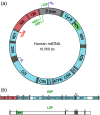Mechanisms of mammalian mitochondrial transcription
- PMID: 31309618
- PMCID: PMC6699104
- DOI: 10.1002/pro.3688
Mechanisms of mammalian mitochondrial transcription
Abstract
Numerous age-related human diseases have been associated with deficiencies in cellular energy production. Moreover, genetic alterations resulting in mitochondrial dysfunction are the cause of inheritable disorders commonly known as mitochondrial diseases. Many of these deficiencies have been directly or indirectly linked to deficits in mitochondrial gene expression. Transcription is an essential step in gene expression and elucidating the molecular mechanisms involved in this process is critical for understanding defects in energy production. For the past five decades, substantial efforts have been invested in the field of mitochondrial transcription. These efforts have led to the discovery of the main protein factors responsible for transcription as well as to a basic mechanistic understanding of the transcription process. They have also revealed various mechanisms of transcriptional regulation as well as the links that exist between the transcription process and downstream processes of RNA maturation. Here, we review the knowledge gathered in early mitochondrial transcription studies and focus on recent findings that shape our current understanding of mitochondrial transcription, posttranscriptional processing, as well as transcriptional regulation in mammalian systems.
Keywords: MTERF1; POLRMT; TEFM; TFAM; TFB2M; mitochondrial RNA processing; mitochondrial gene expression; mitochondrial transcription.
© 2019 The Protein Society.
Figures



Comment in
-
On separation and coding capacity of mtDNA strands.Protein Sci. 2020 May;29(5):1070. doi: 10.1002/pro.3840. Epub 2020 Feb 22. Protein Sci. 2020. PMID: 32057149 Free PMC article. No abstract available.
Similar articles
-
Mitochondrial DNA Transcription and Its Regulation: An Evolutionary Perspective.Trends Genet. 2018 Sep;34(9):682-692. doi: 10.1016/j.tig.2018.05.009. Epub 2018 Jun 23. Trends Genet. 2018. PMID: 29945721 Review.
-
Structural models of mammalian mitochondrial transcription factor B2.Biochim Biophys Acta. 2015 Aug;1849(8):987-1002. doi: 10.1016/j.bbagrm.2015.05.010. Epub 2015 Jun 8. Biochim Biophys Acta. 2015. PMID: 26066983
-
TEFM is a potent stimulator of mitochondrial transcription elongation in vitro.Nucleic Acids Res. 2015 Mar 11;43(5):2615-24. doi: 10.1093/nar/gkv105. Epub 2015 Feb 17. Nucleic Acids Res. 2015. PMID: 25690892 Free PMC article.
-
Regulation of energy metabolism during early mammalian development: TEAD4 controls mitochondrial transcription.Development. 2018 Oct 1;145(19):dev162644. doi: 10.1242/dev.162644. Development. 2018. PMID: 30201685 Free PMC article.
-
The transcription machinery in mammalian mitochondria.Biochim Biophys Acta. 2004 Dec 6;1659(2-3):148-52. doi: 10.1016/j.bbabio.2004.10.003. Biochim Biophys Acta. 2004. PMID: 15576046 Review.
Cited by
-
Identification of TEFM as a potential therapeutic target for LUAD treatment.J Transl Med. 2024 Jul 29;22(1):692. doi: 10.1186/s12967-024-05483-2. J Transl Med. 2024. PMID: 39075464 Free PMC article.
-
Enhanced dynamicity: evolutionary insights into amphibian mitogenomes architecture.BMC Genomics. 2025 Mar 17;26(1):261. doi: 10.1186/s12864-025-11480-6. BMC Genomics. 2025. PMID: 40097969 Free PMC article.
-
On separation and coding capacity of mtDNA strands.Protein Sci. 2020 May;29(5):1070. doi: 10.1002/pro.3840. Epub 2020 Feb 22. Protein Sci. 2020. PMID: 32057149 Free PMC article. No abstract available.
-
Bioinformatics analysis of epigenetic and SNP-related molecular markers in systemic lupus erythematosus.Am J Transl Res. 2021 Jun 15;13(6):6312-6329. eCollection 2021. Am J Transl Res. 2021. PMID: 34306371 Free PMC article.
-
PGC-1α protects from myocardial ischaemia-reperfusion injury by regulating mitonuclear communication.J Cell Mol Med. 2022 Feb;26(3):593-600. doi: 10.1111/jcmm.16236. Epub 2021 Jan 19. J Cell Mol Med. 2022. PMID: 33470050 Free PMC article. Review.
References
-
- Shah R, Schwach J, Frankenberg‐Dinkel N, Gartner W. Complex formation between heme oxygenase and phytochrome during biosynthesis in pseudomonas syringae pv. Tomato. Photochem Photobiol Sci. 2012;11:1026–1031. - PubMed
-
- McBride HM, Neuspiel M, Wasiak S. Mitochondria: more than just a powerhouse. Curr Biol. 2006;16:R551–R560. - PubMed
-
- Adam‐Vizi V, Chinopoulos C. Bioenergetics and the formation of mitochondrial reactive oxygen species. Trends Pharmacol Sci. 2006;27:639–645. - PubMed
-
- Anderson S, Bankier AT, Barrell BG, et al. Sequence and organization of the human mitochondrial genome. Nature. 1981;290:457–465. - PubMed
-
- Bibb MJ, Van Etten RA, Wright CT, Walberg MW, Clayton DA. Sequence and gene organization of mouse mitochondrial DNA. Cell. 1981;26:167–180. - PubMed
Publication types
MeSH terms
Substances
Grants and funding
LinkOut - more resources
Full Text Sources
Miscellaneous

